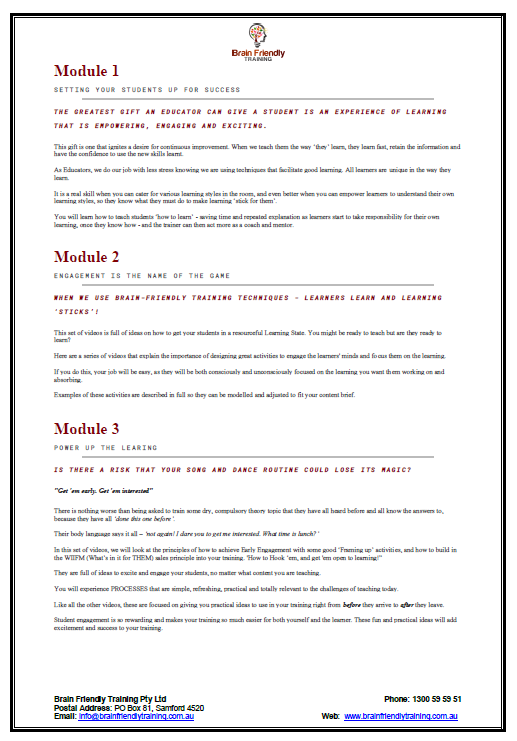Master Trainer Series
Subscription
.png?lmsauth=42ebc910713e3ffbdca64fc4ba12059afceff8b4) Transform your training delivery & the outcomes you achieve!
Transform your training delivery & the outcomes you achieve!
Gain instant access to exclusive Laurie Kelly’s Brain Friendly Training videos in this Annual Subscription! Learn the different tips, secrets, and techniques that will dramatically improve your learning environment and teaching methods – 80+ videos full access immediately for one year!
10+ hours of video based tips, tricks and training strategies.
10% Discount! for VET PD Series subscribers - Use your discount code when purchasing!
Main Takeaways:
- Gain instant access to all of Laurie Kelly’s Brain Friendly Training videos
- 80+ Exclusive, Short Video Clips from Australia’s renowned training guru
- Dramatically improve trainer skills, and staff engagement
- Video focus on both face-to-face and online delivery!
Other purchase options...
Why Should You Learn Brain Friendly Techniques?
Because…
This is What Will You Learn:
- Critical techniques needed for every situation
- How to create powerful lesson overviews
- How to teach using all the senses to maximise learning
- How to deliver the lessons that engages all of your learners’ brains
- Range of strategies and activities to keep students awake
- How to unlock the potential of the students’ minds throughout every lesson
- How to use sound, word, visuals, and movement to ensure your students are engaged
- How to keep your learners engaged and attentive throughout your lesson
- Powerful ways to spark your learners’ curiosity
- How to design and deliver lessons that feel personally real, relevant, and useful
- How to maximise students’ learning of skills and knowledge
- Techniques to improve the learning environment and teaching methods
- How to schedule revisions
- Most common strategies for every educator
- How to execute your learning environment
- How to improve your classroom management and presentation skills
- Why teaching students with the same method is a mistake every educator makes
- Students will easily recall every lesson
- A “great” educator is better that an “ordinary” teacher
- Methods that ensure your learners are always in a perfect, engaged, and “ready to learn” state
- You can be one of the few powerful and gifted educators around the world
- Simple techniques that can dramatically transform your students’ engagement
- Every lessons should “stick” with the students
- Engagement and attention are everything
- “Keeping it real” while training and teaching ensures that learners are deeply engaged
- A great educator needs to master simple skills to make the learning environment interesting and fun
- As an educator, managing the classroom and students is a big deal
Download an Overview of the Series
.png?lmsauth=ce944e75dbb790c5210664577d8db852b6836260)
A Subscription Certificate is issued on commencing the subscription and a Statement of Completion is issued on completion of all video replays!
About Laurie...
 Laurie Kelly is a specialist in Brain-Friendly Training and Delivery Skills that excite and engage the learner. This has been his passion and area of expertise for over 30 years, and this focus is drawn from his wealth of experience, his love for his subject and his ability to rekindle enthusiasm and passion in even the most weary of Educators.
Laurie Kelly is a specialist in Brain-Friendly Training and Delivery Skills that excite and engage the learner. This has been his passion and area of expertise for over 30 years, and this focus is drawn from his wealth of experience, his love for his subject and his ability to rekindle enthusiasm and passion in even the most weary of Educators.
Laurie Kelly’s primary aim is to make great Professional Development available to all trainers anywhere, at any time, through both his face-to-face training and a blended delivery online model. His Professional Development is about engagement and learning in a brain friendly way. He and his team endeavour to assist Trainers, Educators and Facilitators to understand the power of including current Neuro research in the delivery of their material, so that Learners learn quickly and the Learning sticks. Other groups offer Professional Development in assessment and validation - we offer exciting, fun and brain-based techniques that allow you to deliver any content in a brain friendly and engaging way, using simple, practical ideas that work. Your training will never be the same again.
Subscribe now!
Note that at the end of your first year subscription, you will receive an advisory for cancellation 30 days prior to auto-renewal of your subscription.
![]()
CORE AREAS
TRAINING (Revised SRTO) - VOCATIONAL TRAINING INCLUDING COMPETENCY-BASED TRAINING (SRTO2015)
- Planning Vocational Training
- Plan vocational training
- Design a plan for vocational training
- Facilitating Training
- Plan and prepare for vocational training
- Customise vocational training
- Develop session plans for vocational training
- Deliver face-to-face vocational training
- Review vocational training practice
ENGAGING AND SUPPORTING VET STUDENTS (Revised SRTO) - VOCATIONAL LEARNING (SRTO2015)
- Supporting Learning
- Support individual and group learning






